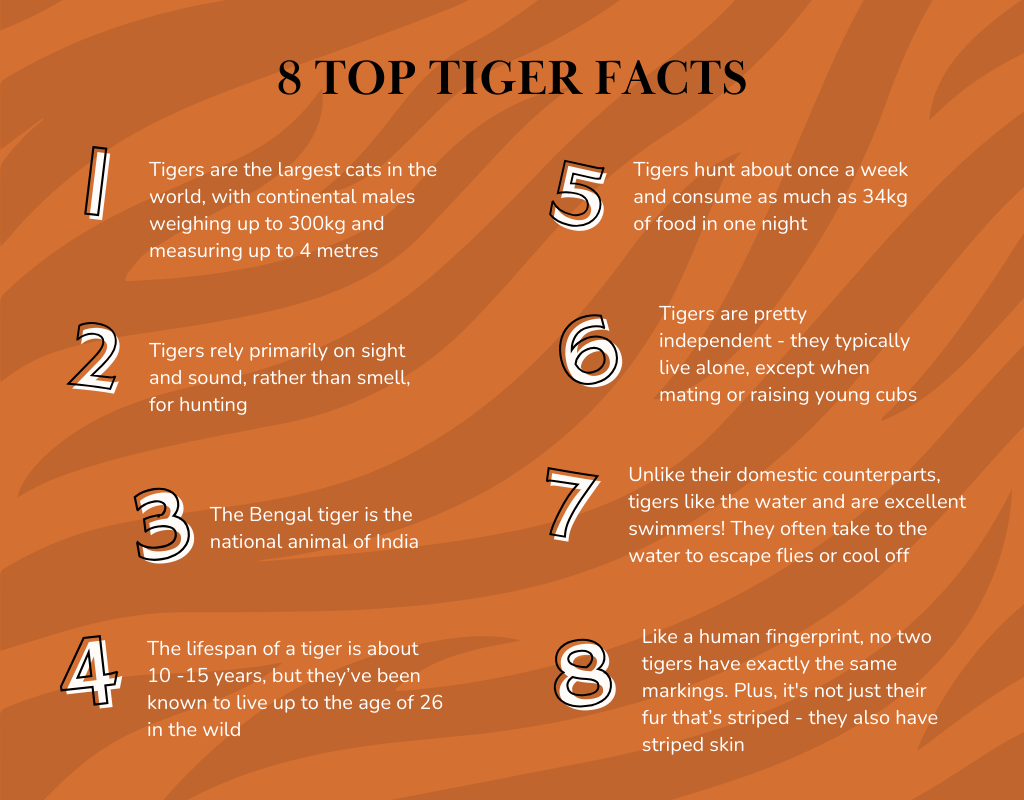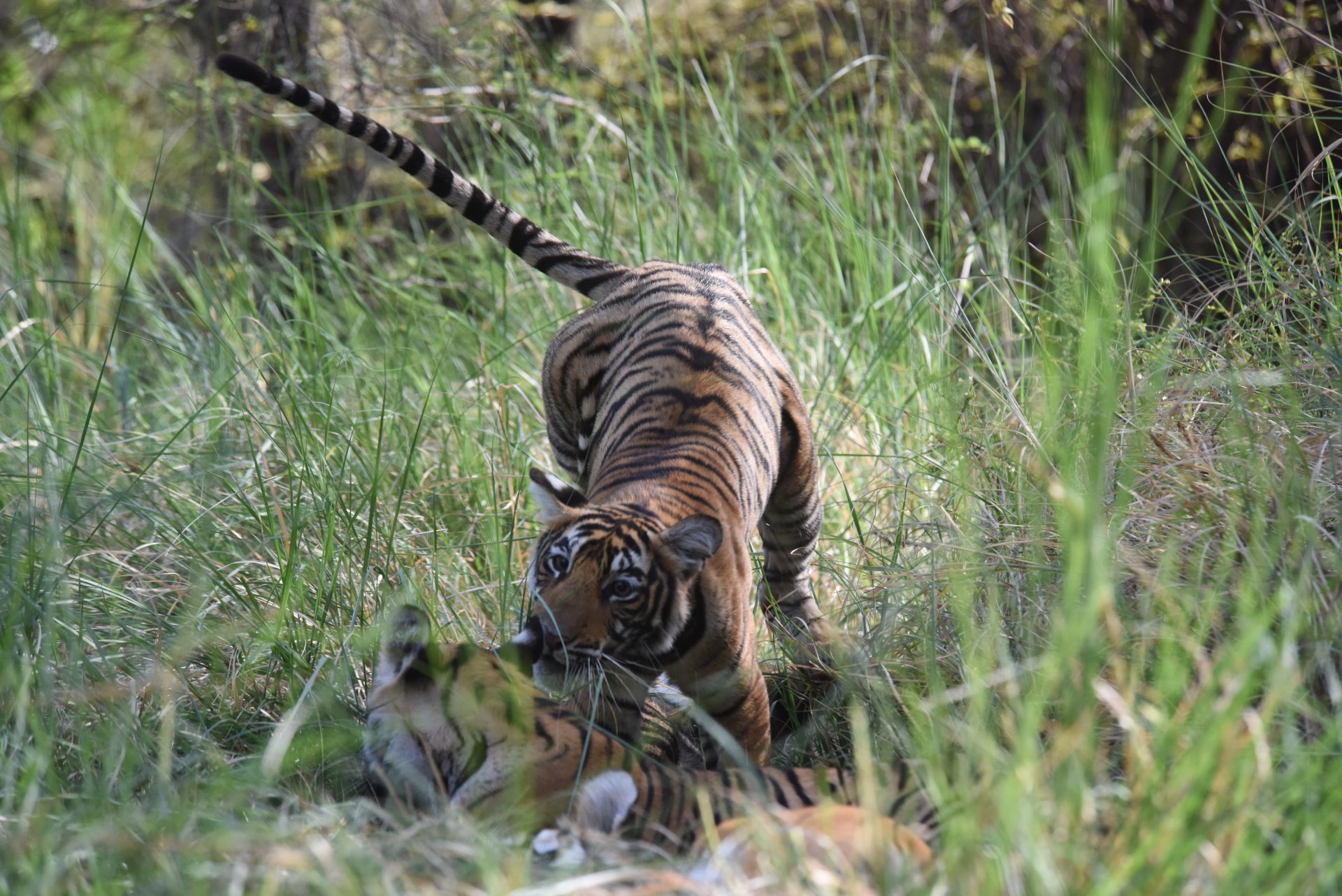You might not want to invite a tiger for tea, but perhaps you’ve always been curious about this magnificent creature, or have dreamed of someday seeing one in the wild. So grab a cup of tea or coffee and read on to discover what exactly is so captivating about the largest cat species in the world, the troubles they’re facing, and where you might see one for yourself one day.
The Allure of the Tiger
The graceful, majestic tiger has captured the imagination of humanity for centuries. Their distinctive stripes, strong presence, and symbolic resonance across different cultures has led us to tell stories about them for years. And while they are one of the world’s most powerful predators, the tiger is currently fighting for survival in a changing world.

Tiger Classification
The classification of tigers can be a bit confusing. While there were previously believed to be nine subspecies of tiger, with six remaining today, since 2017 the International Union for Conservation of Nature (IUCN) has recognised just two tiger subspecies: the continental tiger and the Sunda island tiger.
Continental tigers
Includes the Bengal, Malayan, Indochinese, and Amur (Siberian) tiger populations. The Caspian tiger, also a continental subspecies, is extinct in the wild, while the South China tiger is believed to be functionally extinct.
Sunda island tigers
Popularly known as the Sumatran tiger, and found only in Sumatra. Sunda island tigers also include the extinct Javan and Bali tigers.
Scientists classified tigers into these subspecies by comparing skull measurements, fur pattern, ecology, and genetics. Some scientists disagree with the classifications, believing that those classified as continental tigers show enough difference genetically to be considered six separate subspecies. It’s an interesting and complex topic, but shouldn’t get in the way of priority number one: saving the tiger from extinction, which is important for so many reasons.
In 2010, governments of the world’s 13 tiger range countries came together to create a blueprint for tiger recovery. With increased collaboration between leaders, conservation organisations, donors, and the communities who live in tiger territory, tiger numbers have been slowly ticking upwards in recent years.
According to The World Wide Fund for Nature (WWF), tiger populations are stable or increasing in India, Nepal, Bhutan, Russia and China.
Still, we have some way to go if we are to secure the tiger’s future in the wild. In some areas, including much of Southeast Asia, tigers are still in crisis and declining in number.
Tourism infrastructure in key tiger habitats has been improving, meaning that se knowing that they are having minimal impact on the animals. Visiting them in the much more ethical and sustainable alternative to visiting tigers in captivity.
Tigers are the largest cats in the world, with continental males weighing up to 300kg and measuring up to 4 metres

International Tiger Day
Tigers are found in far east Russia, parts of North Korea, China, India, Southwest Asia and the Indonesian island of Sumatra. But the human population has unfortunately encroached on tiger habitats, pushing tigers onto the endangered list.
International Tiger Day, also called Global Tiger Day, is celebrated every year on 29 July, with the purpose of raising awareness about tigers and their endangered status. According to the Global Tiger Forum, as of 2023 there were just 5500 tigers remaining in the wild. Other sources state there are only between 3000 and 4000 remaining. Compare this with the nearly 100,000 that roamed Asia in the 20th century! Today, they enjoy less than 5% of their historical range.
Factors threatening the survival of the tiger are the usual culprits: illegal wildlife trade, human-wildlife conflict, habitat loss and fragmentation and, of course, climate change. Although tigers are a protected species, there is a thriving illegal trade in their body parts. Tiger parts are used for everything ranging from ornamental tiger-skin rugs to traditional medicine products like tiger bone wine.
To be part of the solution, consider learning about more tigers and the particular problems they face, educating others, or donating to WWF to support the great work they do. You can even symbolically adopt a tiger!
Where Can I See a Tiger?
Has it always been on your bucket list to see a tiger in the wild? You’re not alone – Andrew went in search of a tiger a few years ago which was a life-changing experience!India is a great choice if you’re wanting to see a tiger for yourself. According to WWF, around 3700 of the world’s tigers are in India – around 75% of the total tiger population. Tigers are the largest cats in the world, with continental males weighing up to 300kg and measuring up to 4 metres

Brief Tours Ideas With Tiger Sighting Opportunities:
In Search of Three Big Cats
This 14-night tour takes you on an exciting search for three of the big cats – the Asiatic lion, the leopard, and, of course, the tiger! The tour meanders from Mumbai to Delhi, taking in national parks and sanctuaries where you have the opportunity to spot these majestic creatures as well as a host of other wildlife.
Ganges River Cruise Plus Tiger
On this tour, you’ll spend seven nights on board the Bengal Ganga Ship and explore the rich history of the Gages visiting temples, monuments and palaces along the river. Next, you’ll travel to Kanha National Park for four nights of tiger spotting.
Heritage and Wildlife of Central India
This offers a wonderful mixture of culture and wildlife spread over 14 nights. Explore bustling Delhi, visit lakes, temples and palaces and enjoy game drives in three national parks – Satpura, Kanha and Pench, where you’re likely to see a variety of fascinating creatures including – fingers crossed – the beautiful tiger.
Several of our tours to India offer opportunities to see tigers in the wild, please ask us at Wildlife Escapes for more details.



